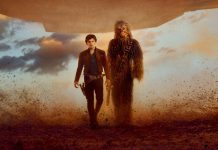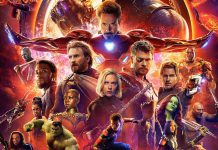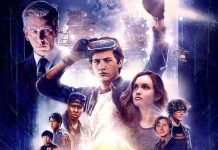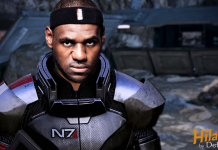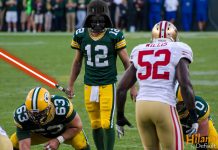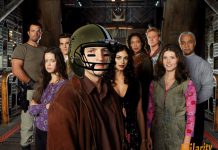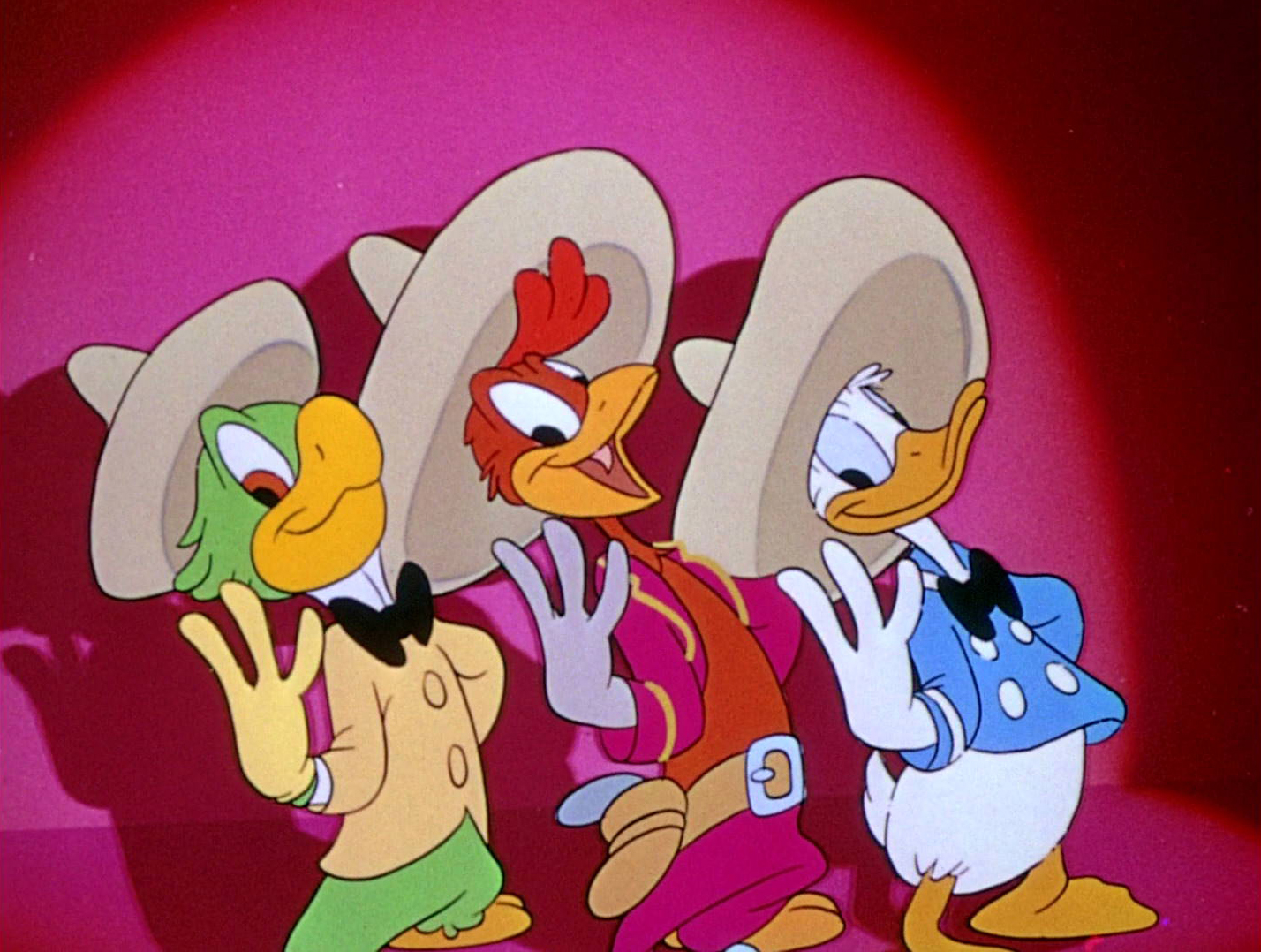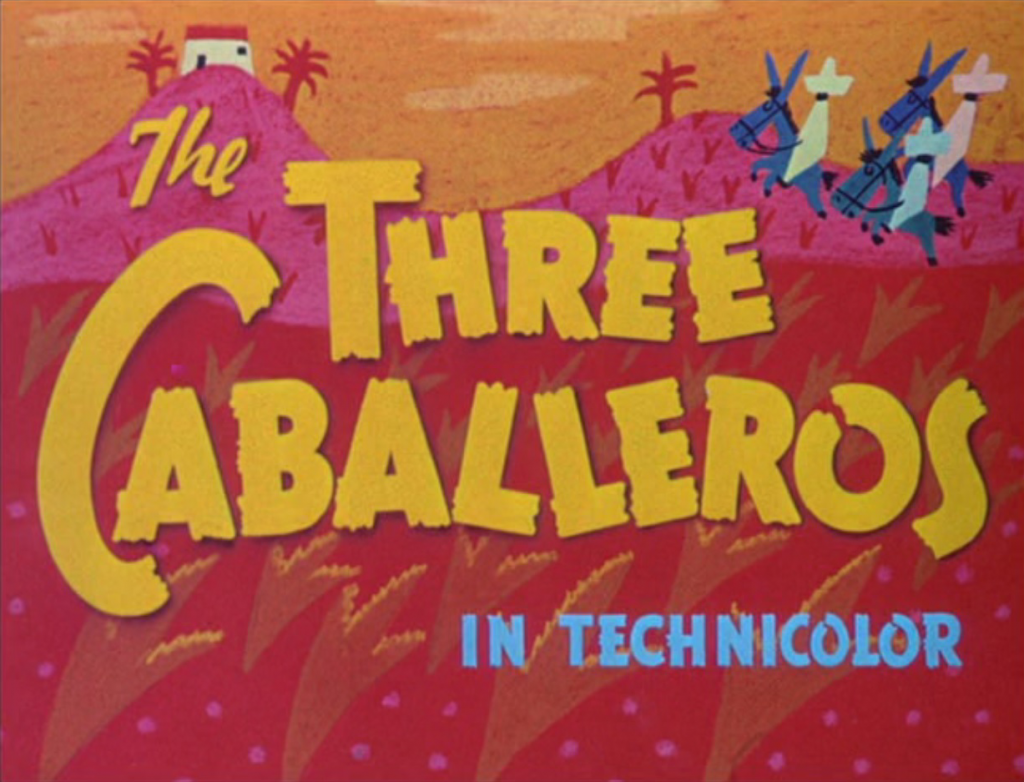To say that The Three Caballeros is one of the most unusual entries in the Disney canon is an understatement. Perhaps the most well-known of the six package films released between 1942 and 1949, it is, nevertheless, a jumbled production seesawing aimlessly between engaging masterwork and bizarre lunacy. What other Disney film can be said to include such a varied collection of strange characters and absurdity such as flying donkeys, men who turn into cock-fighting roosters, and singing flower women who transform into weird human/horse hybrids?
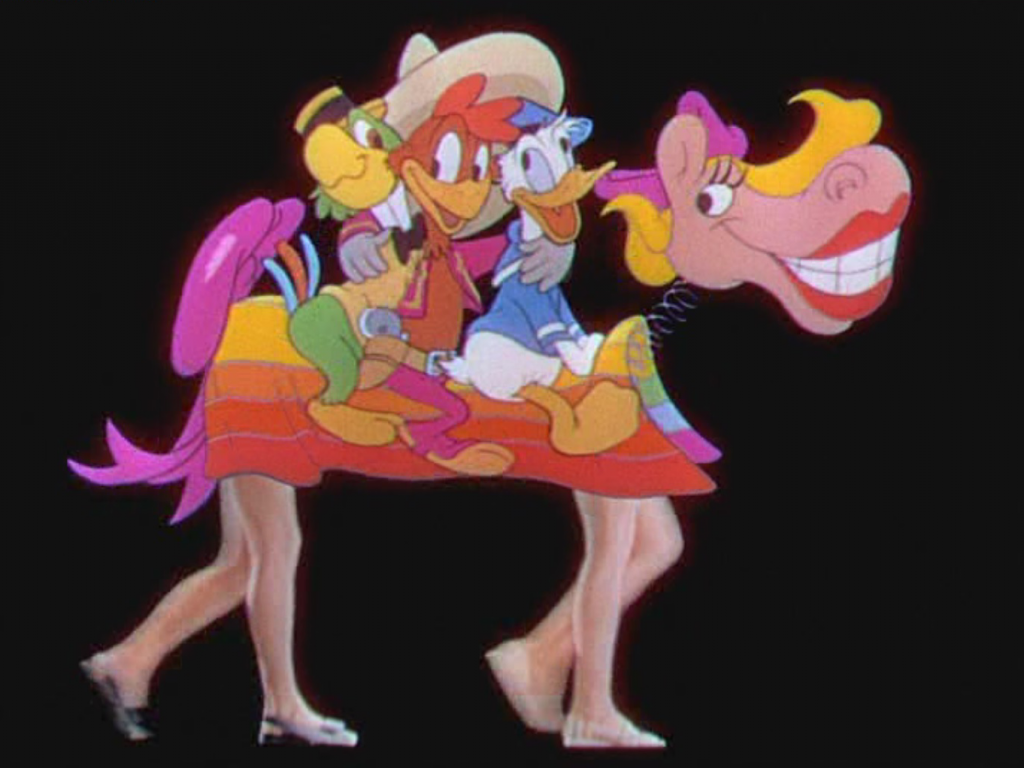
Yet, with a frenetic, comic energy (the likes that wouldn’t be seen again until Aladdin), a truly memorable collection of Latin music, and the most popular Disney character of the time with Donald Duck, it’s obvious to see why the film was able to overcome it’s dismal package feature origins.
Walt Disney’s The Three Caballeros |
The second of Walt Disney‘s two Latin American goodwill pictures, The Three Caballeros is much more manic than the more deliberate Saludos Amigos. Where Amigos strived to educate, Caballeros is more inclined to be an immersive experience. This is a film that truly relishes its journey into South American culture and music. Thus, what would constitute as a normal three-act story structure is altogether thrown out the window in favor of a sometimes overwhelming saturation of atmosphere and character.
Unlike the other package features, The Three Caballeros puts more work into threading together its various sections resulting in a more complete experience despite its narrative shortcomings. There’s some debate on exactly how many distinct sequences are actually featured but the general consensus is that the film is comprised of seven shorts intertwined by the celebration of Donald Duck’s birthday on Friday the 13th.
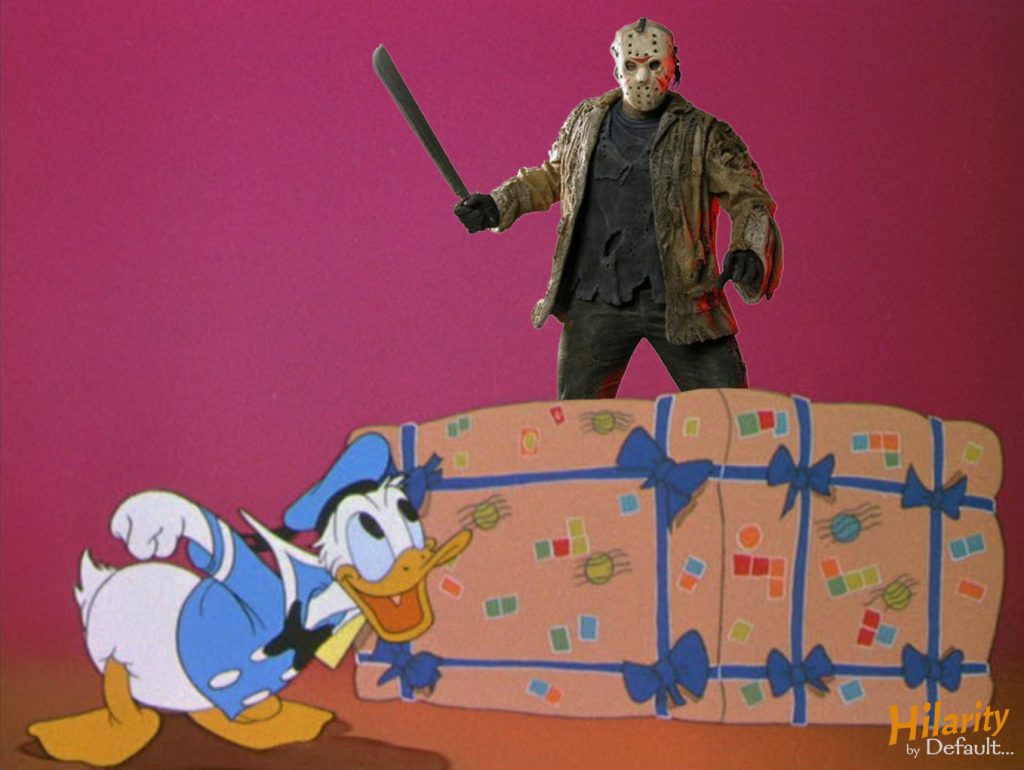
The film begins with Donald opening a package “from his friends in Latin America” to discover three birthday presents. The first contains a projector and a film reel entitled “Aves Raras,” or “Strange Birds.” This kicks off the two most conspicuous shorts in the picture: “The Cold-Blooded Penguin” and “The Flying Gauchito.”
“The Cold-Blooded Penguin” |
Narrated by Winnie the Pooh himself, Sterling Holloway, “The Cold-Blooded Penguin” is easily the most charming and enjoyable of the two shorts. It’s the story of a rebellious little penguin named Pablo who desires nothing more than to leave the frigid South Pole behind for a life in a tropical paradise. After a few comically flawed attempts, he fashions an ice-boat and embarks on his journey.
“The Cold-Blooded Penguin” is a joy. Pablo is endearing and his mercurial antics are amusing. Although the South American geography lesson as he sails to his tropical destination may seem a bit obligatory, the visual puns to the story’s narration are inspired and help offset any flaws.
Following “The Cold-Blooded Penguin,” there is a short segment featuring more of Donald’s South American feathered cousins including an offbeat character called the Aracuan Bird. Literally jumping in and out of the projection…
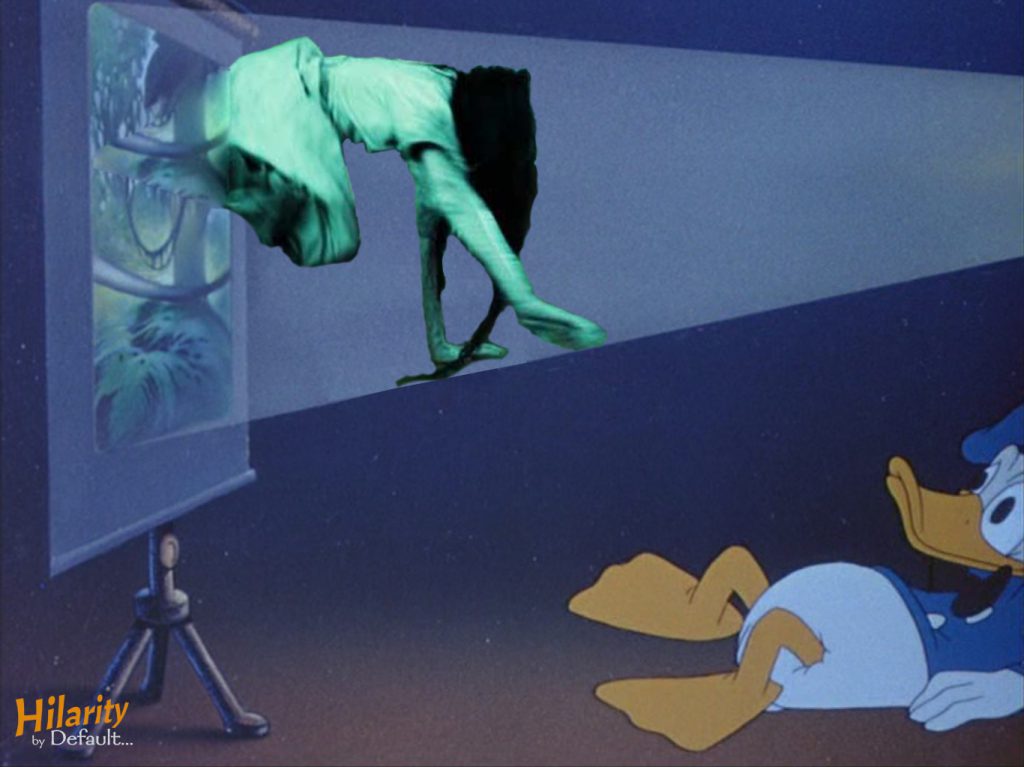
…while singing his deranged little song, the Aracuan has more in common with a zany Warner Brothers character (such as the early versions of Daffy Duck) than the more ordinary Disney fair, and serves as the first hint of the wilder tendencies the film would ultimately bestow.
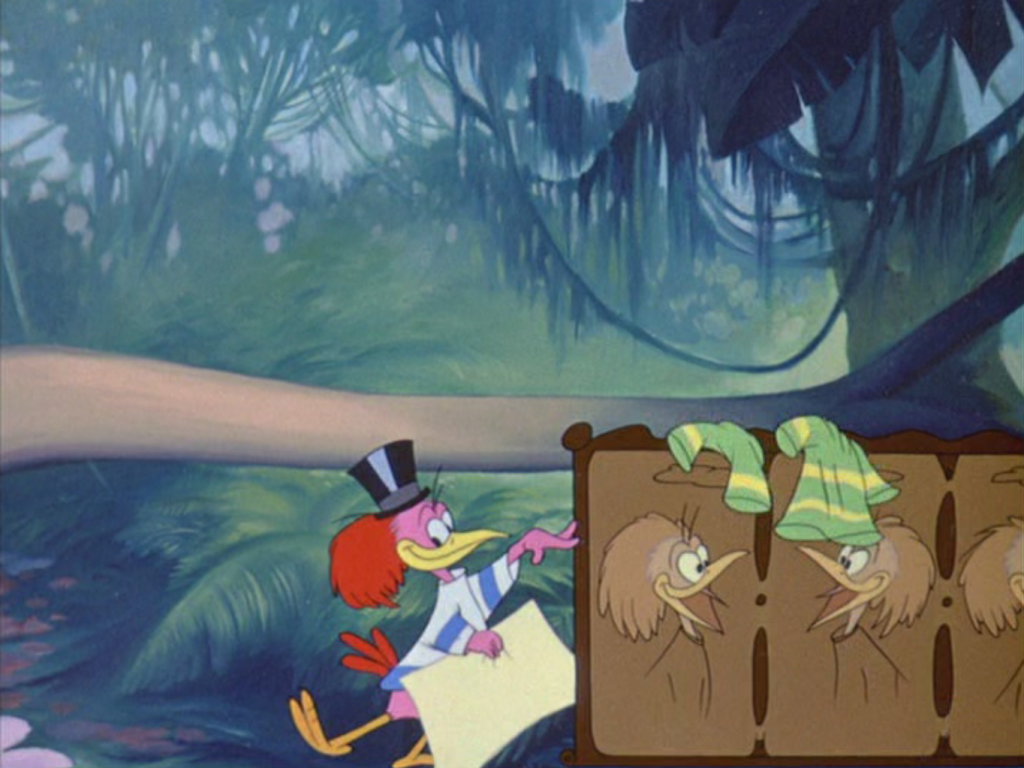
It’s not particularly surprising that he became popular enough to reappear in the hilarious Donald Duck short “Clown of the Jungle” and once again in Melody Time along with his Caballeros costars, Donald and José Carioca. His frenzied spirit is a highlight of the film and thankfully downplayed enough not to become annoying – a fallacy that such a character could easily instigate.
“The Flying Gauchito” |
“The Flying Gauchito” is a cute little short but overall it is the weaker part of the film’s first third. In many ways, it feels like a retread of “El Gaucho Goofy” from Saludos Amigos supplanting Goofy‘s comic hilarity with the silly story of a little gaucho who discovers a flying donkey while hunting. Naturally, he enters him in a horse race.
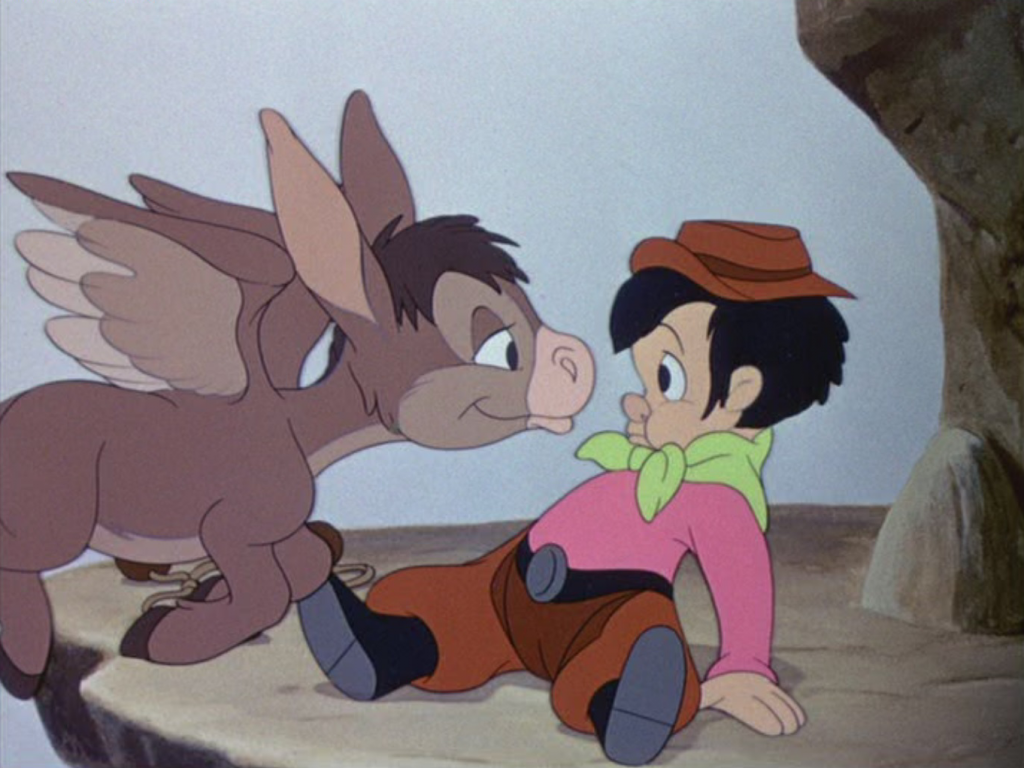
While there are some amusing gags with the unreliable narrator and the donkey’s antics, the story is thin and the educational aspects plus sentimentality feel more forced than they did in “The Cold-Blooded Penguin.” Still, it’s a harmless end to the “Aves Raras” film reel and a prelude to a much more captivating second third of the feature.

“Baía” |
Continuing the “Good Neighbor” tour of South America, we are reintroduced to José Carioca from Saludos Amigos as Donald Duck opens his second present – a pop-up book entitled “Brazil.” José, who was one of the highlights from Amigos, shines here and is a welcome dose of energy. As he’s introduced playing his umbrella to the tune of a Latin beat, it is evident that he will be utilized far more effectively here than his paltry few minutes of screen-time in the previous film.
Unlike the modern day censoring of the cigarettes from Saludos Amigos and Melody Time, Disney once again thankfully leaves José’s cigar alone. Contrary to most of the Disney package features, The Three Caballeros isn’t undermined by any censorship at all. Despite Goofy and Pecos Bill respectively having their cigarettes snuffed, José smokes to his lung’s content – to the point where his very introduction is trumpeted with the pop-up book puffing with cigar smoke!
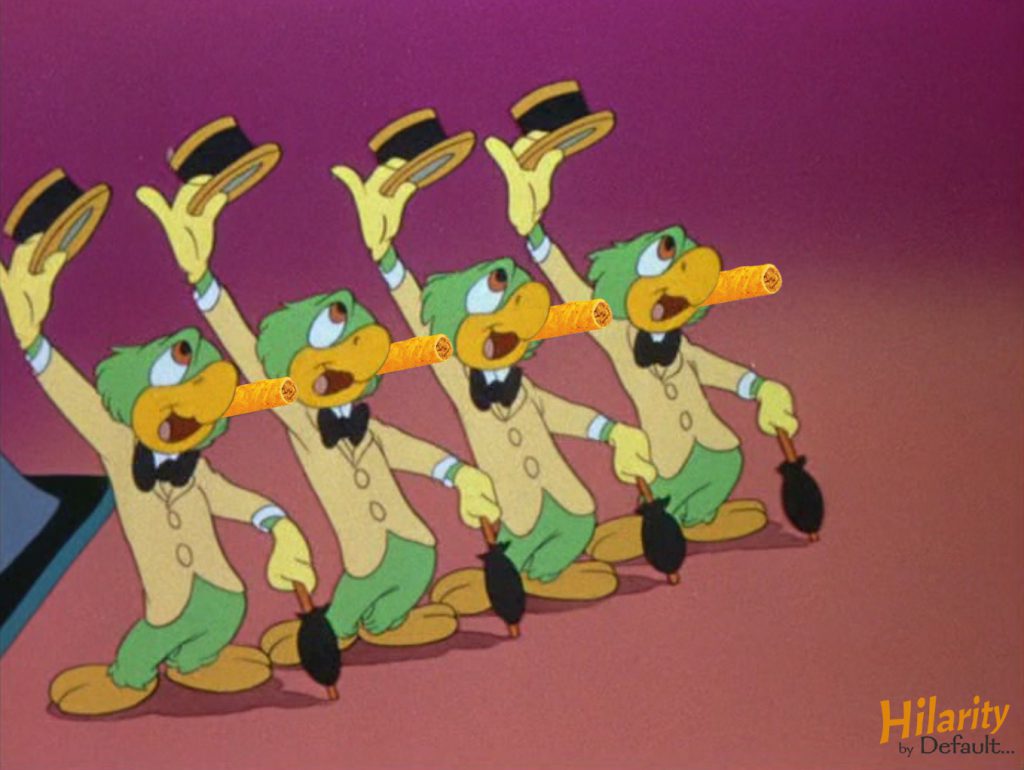
Having already toured Rio de Janeiro in Amigos, José now introduces Donald to Brazil’s fifth largest state – Bahia (or “Baía” in Portuguese). “Baía” is by far my favorite section of the film. Its dynamic mix of color, music, and imagination is delicious and, as opposed to the wackier portions of Caballeros‘ final third, it maintains a capable balance of whimsy versus insanity.
Broken up into three individual parts, “Baía” begins on one of the film’s few serene sequences as José sings (or, at least, it is implied that he does) a gentle samba tune brought to life with the multiplane camera. Hearkening back to some of the more accomplished animated panoramas of the early Disney features, this is by far the most beautiful section of The Three Caballeros.
As the ballad ends, there is a jarring change in tone as José splits in four (because, why not?) and sings a second song, “Have You Ever Been to Bahia?,” shrinking Donald down to pop-up book size midsong. It’s a kinetic, fun little piece that launches “Baía’s” second section as they both hop into the book and catch a train so brightly colored that it makes Casey Junior from Dumbo look practically monochrome by comparison. The train, which includes a caboose with a square peg for a wheel, takes them on a journey through a Brazilian rain forest to the score of the lively “Pandeiro & Flute.” This is a jaunty little sequence accentuated by the reappearance of the Aracuan bird as he dispels his usual rein of terror, drawing up a multitude of train tracks with a pencil causing each cabin to hurl in different directions in cartoonish fashion.
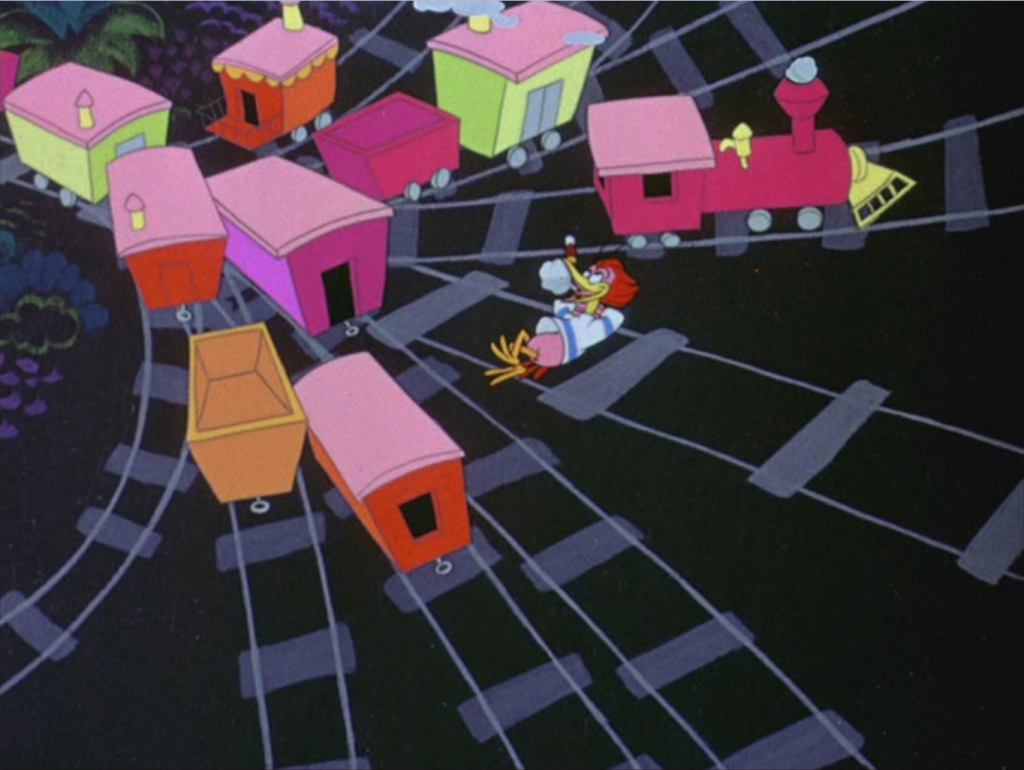
At last, they finally arrive in Baía for the third and main section of the short. This is where The Three Caballeros really comes to life as a live-action Aurora Miranda (sister of the popular Carmen Miranda) impressively saunters through the pages to interact with Donald and José. Walt Disney had experimented with mixing live action and animation before with his “Alice Comedies” of the 1920’s and very briefly with Fantasia, The Reluctant Dragon, and Victory Through Air Power but never to the technical degree and distinction as seen here. Although he would continue to refine this effect briefly in films like Song of the South and Mary Poppins, it would not be until Who Framed Roger Rabbit in 1988 that any Disney picture would feature such a mix as predominantly throughout a single film.
The sequence is quite absorbing as Miranda, or Yayá the cookie merchant as José emphatically calls her, dances and sings “Os Quindins de Yayá” in a pop-up village market.
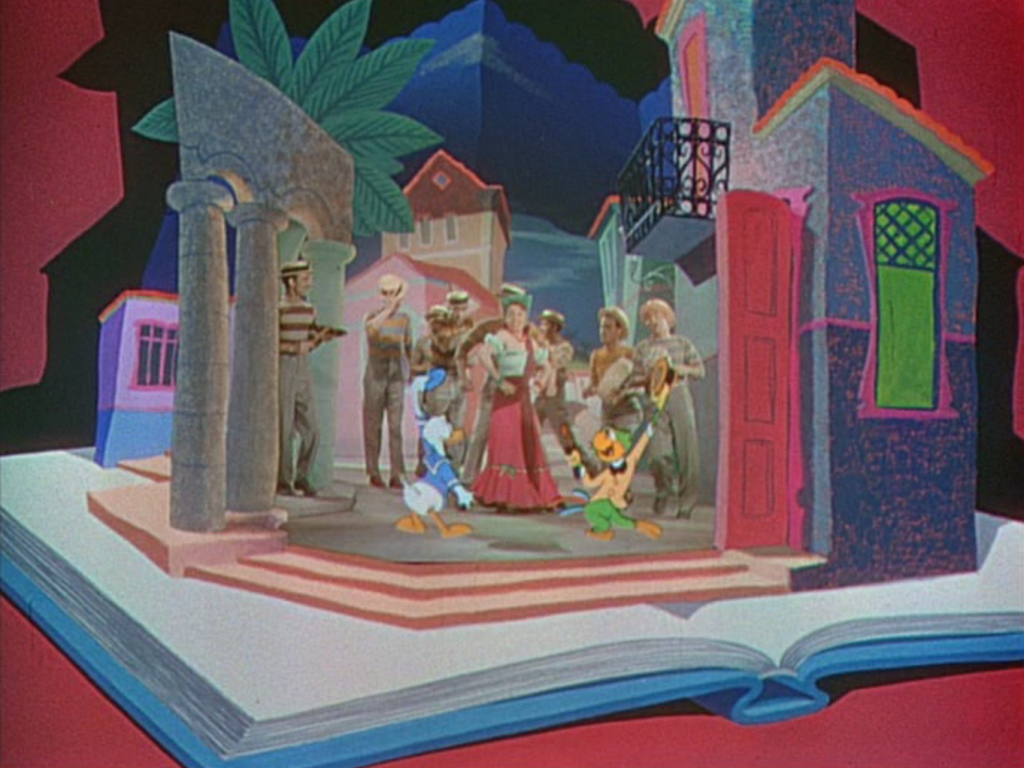
Naturally, every man and duck that comes in contact with Yayá is overpowered by her allure. Come to think of it, for a cookie dealer she doesn’t seem to spend much time selling cookies, instead flirting and dancing with everyone on the street. When an apple seller interrupts Donald’s advances on her, it inspires a comic rage that is closer to the frequently antagonistic Donald from his short cartoons rather than the laid back, everyman persona of Caballeros.
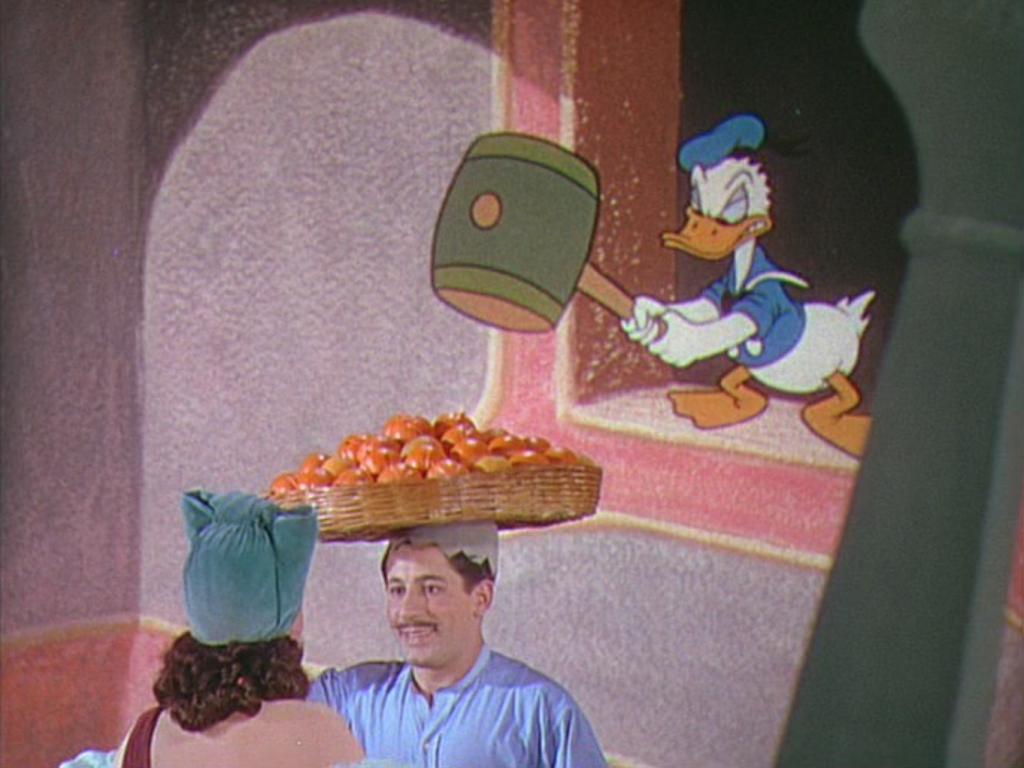
Donald’s overzealous temper is curtailed instead with an agonizing carnal desire (a sentence you never thought you’d read today). This character turn would dominate the rest of the film as he goes hog-wild for absolutely every Latin beauty he comes across. Questionable behavior for a Disney film, perhaps, but the execution here is utterly hilarious and not overtly excessive (yet).
More interesting is the more subtle chronicle of the spurned flirtations between Yayá and Malandro, the guitarist. She teases his advances throughout but then abruptly rebukes him. Not to be outdone, he returns, blatantly spiting her with a handful of singing ladies!
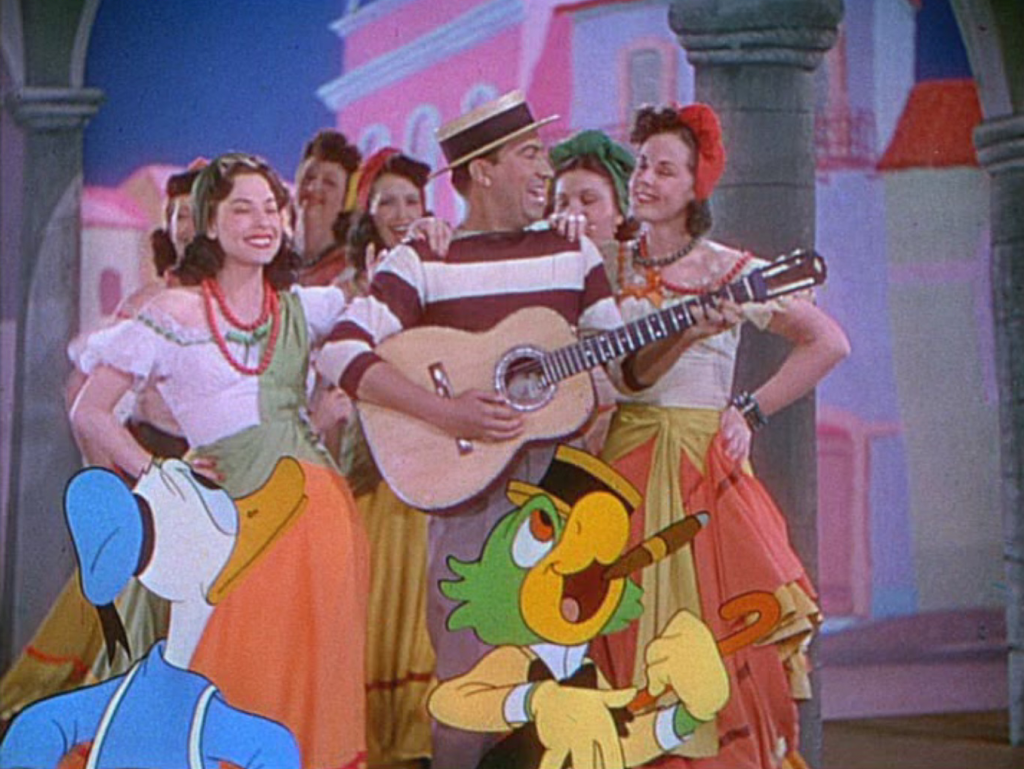
The party having left her behind, Yayá is touched when Donald sticks around and gives his a bouquet of flowers. She gratefully thanks him with a huge kiss – and what a kiss it must have been because Donald’s eyes suddenly metamorphose into spinning anthropomorphic musical instruments before exploding to reveal a dance scene between Yayá and two men who, of course, begin to fight over her, transforming into cockfighting roosters in the process…
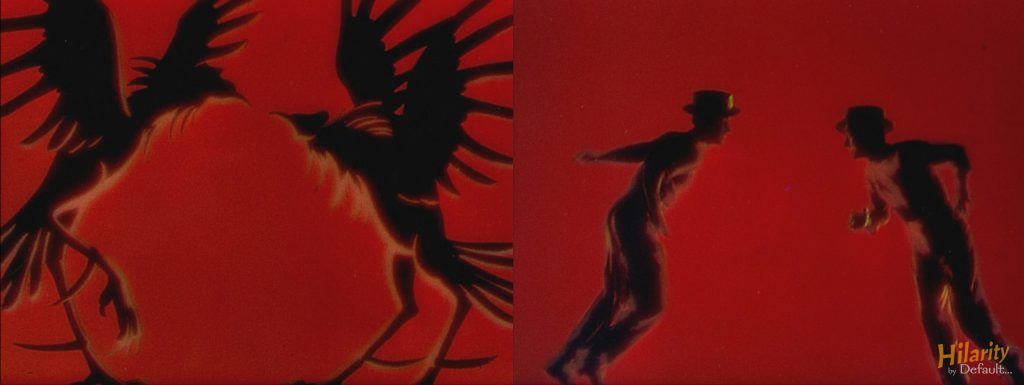
Out of the blue, Yayá is empowered with the magic to bring inanimate items to life as the whole town begins rocking and swaying to the final chorus of the song bringing “Baía” to a strange, but spirited, close.
“Baía” is the most blissful section of The Three Caballeros. Sure, there are a few bizarrely abstract moments but it’s hard not to become caught up with the infectious musical beat and the dazzling interactions of the animated and live action characters (even if it seems a bit archaic compared to Roger Rabbit). Where José Carioca and Donald Duck’s last Brazilian romp in the “Aquarela do Brasil” installment of Amigos fell short just as it was getting revved up, “Baía” overpasses it with just the right proportions of wit and energy.
“Las Posadas” |
After slipping out of the “Brazil” book, José Carioca uses “a little black magic” to return Donald and himself to their normal sizes (maybe one of the only Disney protagonists to ever to use black magic) and they eagerly open the final present, brazenly labelled “Mexico.”
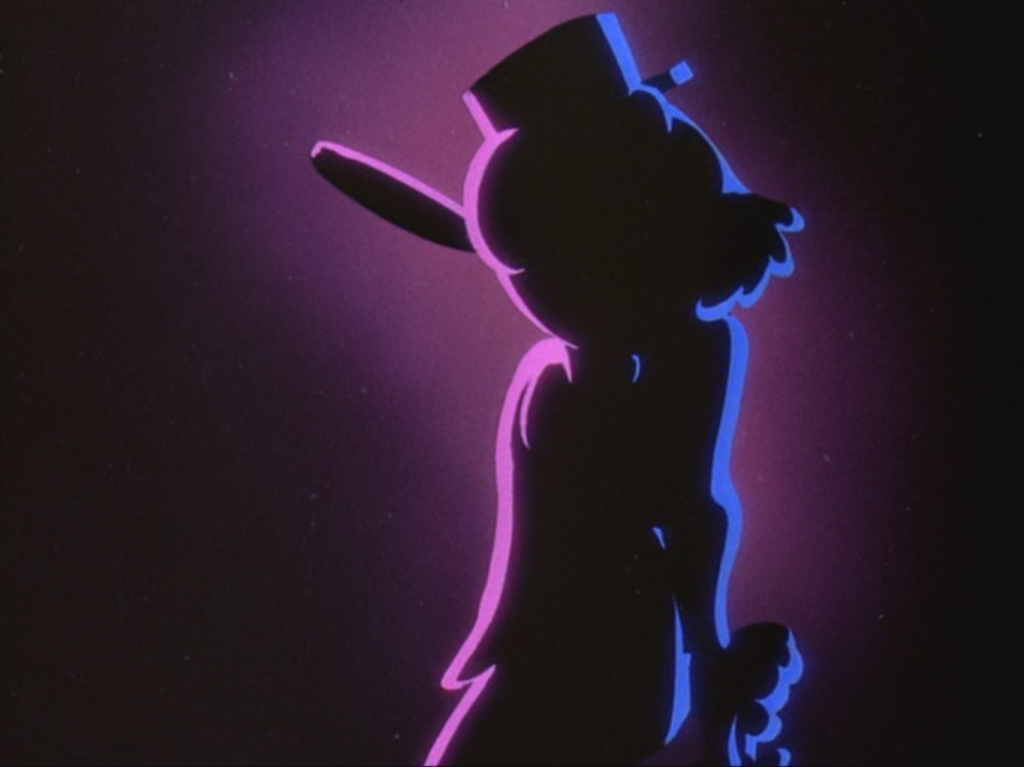
As expected, it explodes (with all the pyrotechnics and various explosives in Donald’s packages, I wonder how hard it must have been to mail it across the border). The screen suddenly becomes engulfed with swirling, vibrant colors as the two dance to tune of “The Three Caballeros.” Reminiscent of the soundtrack portion of Fantasia, it is a mesmerizing sequence that is further highlighted when Donald himself gets caught and becomes part of the animated soundtrack, twisting and turning into a variety of Rorschach-like figures.

Of course, it too explodes (Three Caballeros truly manifests itself as an animated Latin American Michael Bay film), and the third and final caballero – the gun-toting, hyperactive rooster, Panchito Pistoles – at last makes his appearance.

After donning sombreros, the three begin to sing the film’s title song – an absolute joy of hyperkinetic, animated frivolity. The pace is quick and the jokes fly fast in a frenzied sequence that wouldn’t be equaled until “Friend Like Me” from Aladdin. Oddly, it takes a violent, though no less humorous, turn towards the end as Donald and José rush to stop Panchito, who is holding an impossibly long note, using any means necessary – from conflagration, to poison, to axes, to cannons, to…well you get the idea.

Having survived this murderous onslaught, Panchito gives Donald his present – a piñata. Having apparently lived in a cave his entire life (or his unnaturally, unadorned monochrome house which serves as an unusual backdrop for most of the transitory scenes in the film), Donald is absolutely perplexed by what a piñata is. In yet another jarring change in tone, Panchito tells Donald the Mexican Christmas tradition of Las Posadas where, through quaint, postcard style animation, children go door-to-door in search of shelter reenacting Mary and Joseph’s Biblical manger story. Once shelter is found, a celebration ensues and the children participate in the breaking of the customary piñata.
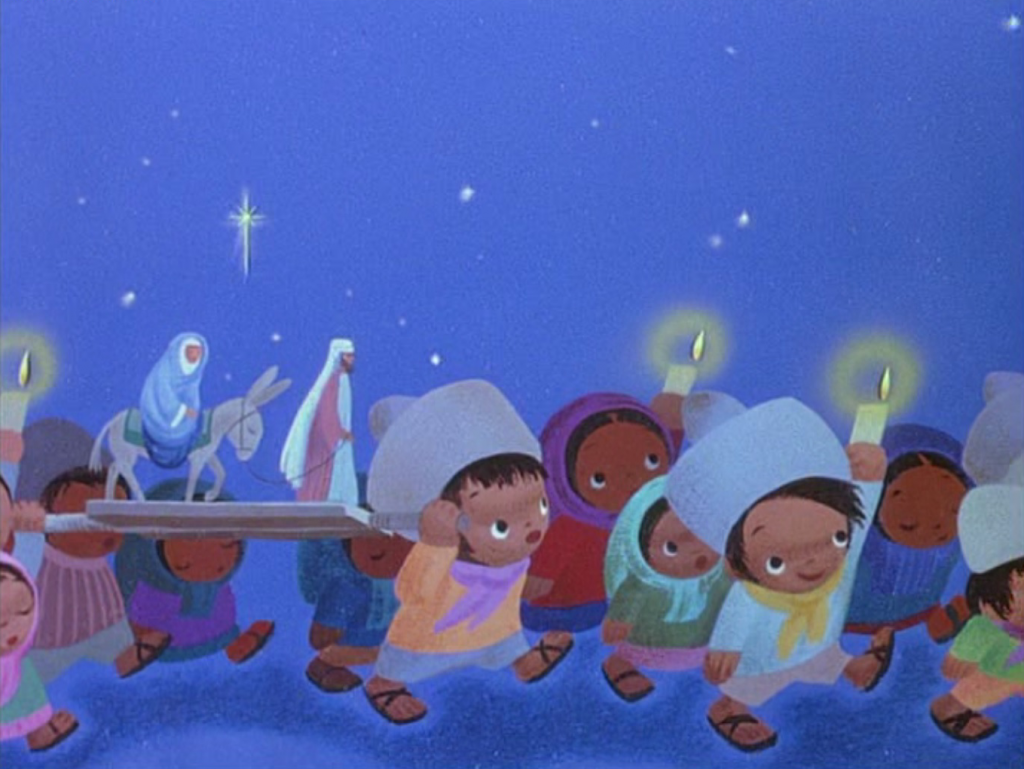
“Las Posadas” is an innocuous little sequence, very reminiscent of the look and style of Disneyland’s It’s a Small World ride which debuted at the 1964 World’s Fair exactly twenty years later. In fact, the great Mary Blair, who was the art supervisor of Caballeros, was also responsible for the design of Small World (and a plethora of other Disney projects). In a bit of irony, when Epcot debuted the El Rio del Tiempo attraction for its Mexican pavilion in 1982, it also included a scene that was inspired by this approach. Twenty-five years later, the ride was retrofitted into The Gran Fiesta Tour Starring the Three Caballeros with this scene intact bringing everything full circle.
“Mexico: Pátzcuaro, Veracruz and Acapulco” |
Following a comic piñata bashing interlude that closes out “Las Posadas,” Panchito shows Donald and José his Mexican postcard collection in a short montage accompanied by the song “Mexico.” It’s a stylish sequence capped off as Panchito (probably using a little of José’s leftover black magic) beckons a “magic serape” and they fly into the now living postcard for a travelogue tour of of the country.
After briefly visiting Pátzcuaro, “the fisherman’s paradise,” and watching a local dance, the “Jarabe Pateño,” they make an enjoyable visit to Veracruz where they interact with a group dancing the “Lilongo.” Our trio joins the festivities as Donald does a jazz dance to impress a clearly baffled woman, José plays musical instruments, and Panchito sings. It’s a marvelous sequence, which makes it a bittersweet shame that The Three Caballeros would steadily go downhill following it.

Their third and final destination takes them to Acapulco Beach, a.k.a. the Disney Studios parking lot. More than any other section in the picture, this sequence feels the most heavily staged with a blatant wall not far behind the entirety of the action [insert obligatory Donald Trump Mexican wall joke here]. After the caballeros scan a cluster of bathing beauties, they literally dive bomb towards them on their flying serape as the girls dash off and scatter from their purported machine gun fire.
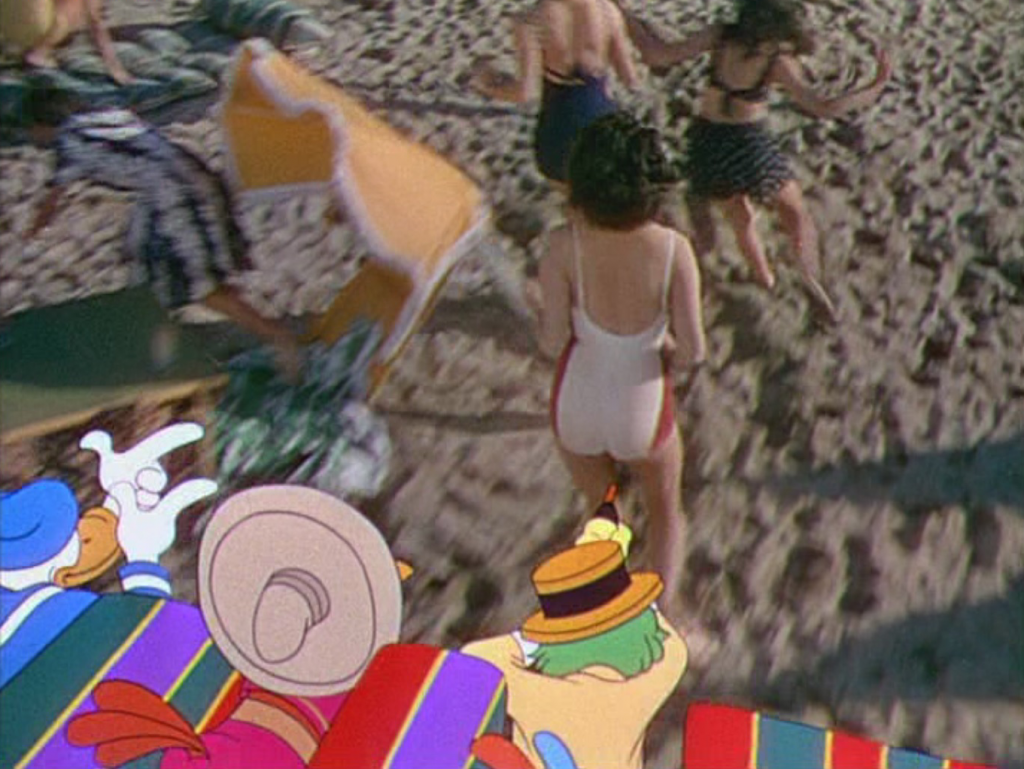
Naturally, Donald dons a bathing suit and joins them as they play out a number of sensual fantasies such a wacky game of blind man’s bluff as he yearningly reaches out to kiss any of the teasing girls. If The Three Caballeros teaches anything it is that Acapulco Beach is an Eden of beautiful, willing nymphs with nary another man in sight. It’s probable that tourism reached all time heights following the release of the film.
On a side note, when I was a kid watching the movie, I was perplexed as to why Donald was chasing all the girls when it was already firmly established in the cartoons that he had a girlfriend named Daisy (who made her initial appearance in Donald’s first solo short cartoon, “Don Donald,” which was, coincidentally, also set in Mexico). I always wondered what she would think of his philandering here…

“You Belong to My Heart” |
The final two sections of The Three Caballeros blend into each other so well (or so peculiarly, depending on your point of view) that I don’t know why there was ever a distinction made between the two entities in the first place. When people refer to the film as being oddball or something related to a drugged out fantasy, they’re more than likely referencing these last two sequences. On one hand, it’s a shame because it contains some astounding animation, one of the best songs in the film (“You Belong to My Heart”), and a boisterous experimental quality that rivals “Pink Elephants on Parade” from Dumbo for outlandish revelry. On the other hand, it’s an oversaturated debacle of confusion, discord, and insanity.
These final two episodes commence with Panchito presenting his final postcards of a starry night over Mexico City (cuing an excited Donald to exclaim “Oh boy, Mexico City!”). As the three gaze at the romantic nightlife of the city, one of the stars transforms into the face of singer Dora Luz as she performs the sweet “You Belong to My Heart.”
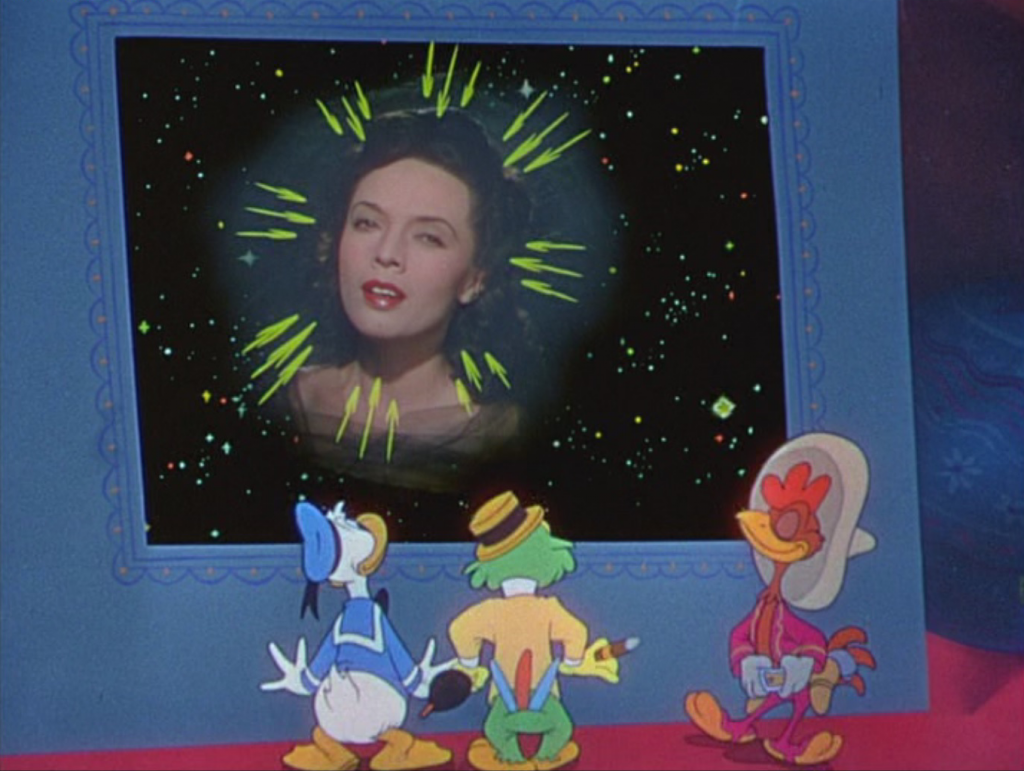
Dora’s bodiless head proves to be the ultimate crème de la crème for Donald as her song enraptures him with animated glee as he floats alongside her with a myriad of shooting stars. The surreal scene that plays out has a few clever touches as the sky becomes flocked with playing guitars in concordance with the lyrics and Donald hops on a multitude of stars and clouds to the beat of the tune. Had the movie ended here, it may have been a slightly underwhelming but adequate conclusion.
“Donald’s Surreal Reverie” |
Instead, as if the writers were at a loss as to how to properly finish the picture, Donald’s reverie continues as several discorporate lips appear and kiss the bashful Duck, who wells up and explodes into a flaming red rocket before landing into a colorful plumage of flowers in what is quite possibly the most flagrant sexual allegory in the film.
The strains of “You Belong to My Heart” take an eerie deviation as Donald hovers over Dora Luz whose face now appears on the base of a giant flower. Just as he leans in for a kiss, she explodes as hallucinations of Panchito and José march out of the flower’s shell and begin shooting pistols and umbrella machine guns!

From this point on, Donald’s phantasmagoric delusions turn into a formidable nightmare of neon creatures, bursting piñatas, half-clad girls, and, to top it all off, his friends dancing in drag. Freud could complete several dissertations analyzing this schizophrenic deluge of a dream!
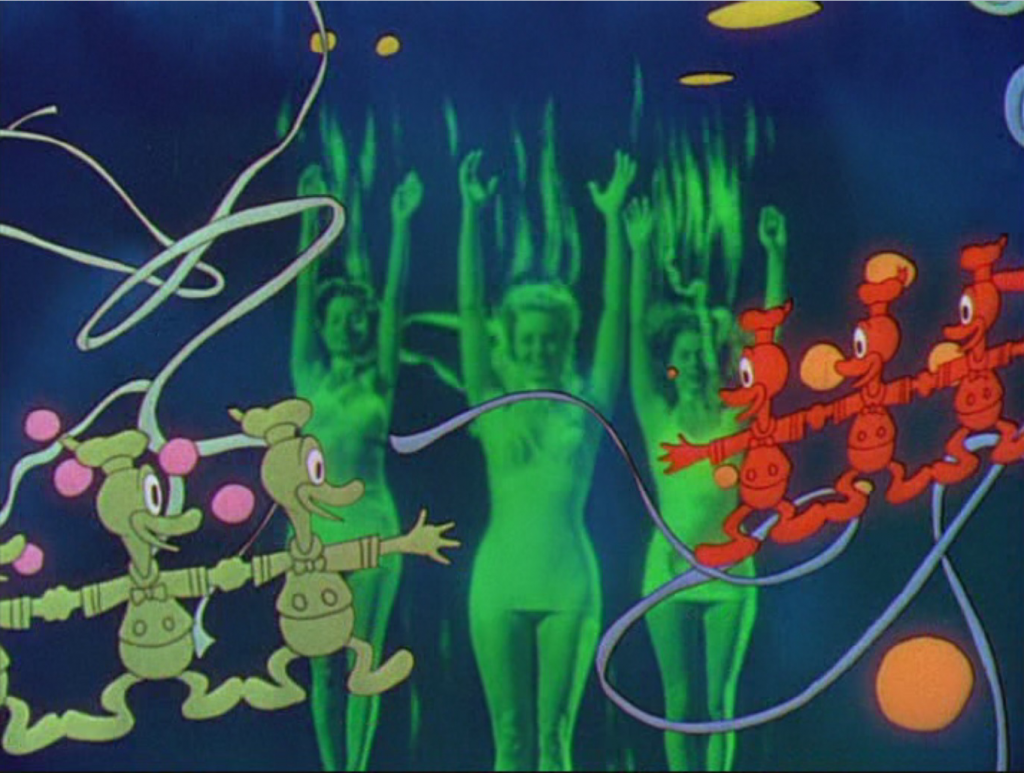
Upon hearing a demonic whispering chant of “purty girls,” the production returns to a slight semblance of lucidity as Donald dances and sways with both a flower and cactus girl to the more traditional tunes of “La Zandunga” and “Jesusita en Chihuahua.” “La Zandunga” features a splendid mix of animation and live-action as Donald flies in and out of a translucent curtain of veiled flowers but much more agreeable is “Jesusita en Chihuahua” which serves as the one true diamond in the rough of the film’s last third. As a cactus morphs into the pretty Carmen Molinda, she is joined by an ensemble of her cacti brethren who, at one juncture, turn into mini-ducks, pestering the dallying Donald. It’s a fun little piece but not strong enough on its own to salvage an already crumbling dénouement.
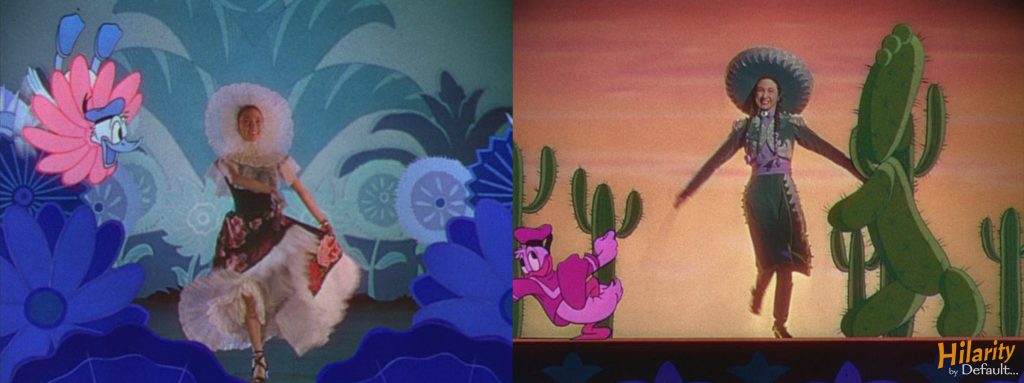
After the cactus girl explodes (because, after all this, why not?), we return to Donald’s house for a cacophonous finale where the three caballeros act out a mock bull fight with Donald riding around in a wheeled bull packed with fireworks which…well, you get the idea by now.
Latin Beats and Childish Treats |
The most distinguishing aspect of The Three Caballeros is the extraordinary music that peppers the film with a contagious ambiance. Featuring an impressive array of handpicked traditional South American songs and compositions, there may not be much originality in the film’s score but it does provide an authentic feel to the whole proceeding. Of all the songs, only four contain any material written specifically for the picture and of those four, only one (strangely enough, “Mexico”) is wholly original. Incidentally, the song “Have You Ever Been to Bahia?,” which is an exact English translation of the number, does feature one minor alteration – the replacement of the word “nega” (slang for a black woman in Portuguese) with “Donald” instead.
Although I have a fondness for “Baía,” “The Three Caballeros” is by far the most memorable song in the film. Set to the tune of “¡Ay, Jalisco, no te rajes!” (whose original lyrics can be heard when Panchito sings them in Spanish near the end of the song), “The Three Caballeros” has a jubilant energy that is matched perfectly by the rambunctious animation that characterize it. Although the lyrics are a bit dated – such as “we’re three caballeros, three gay caballeros” – it would be absolutely childish to point something like that out…

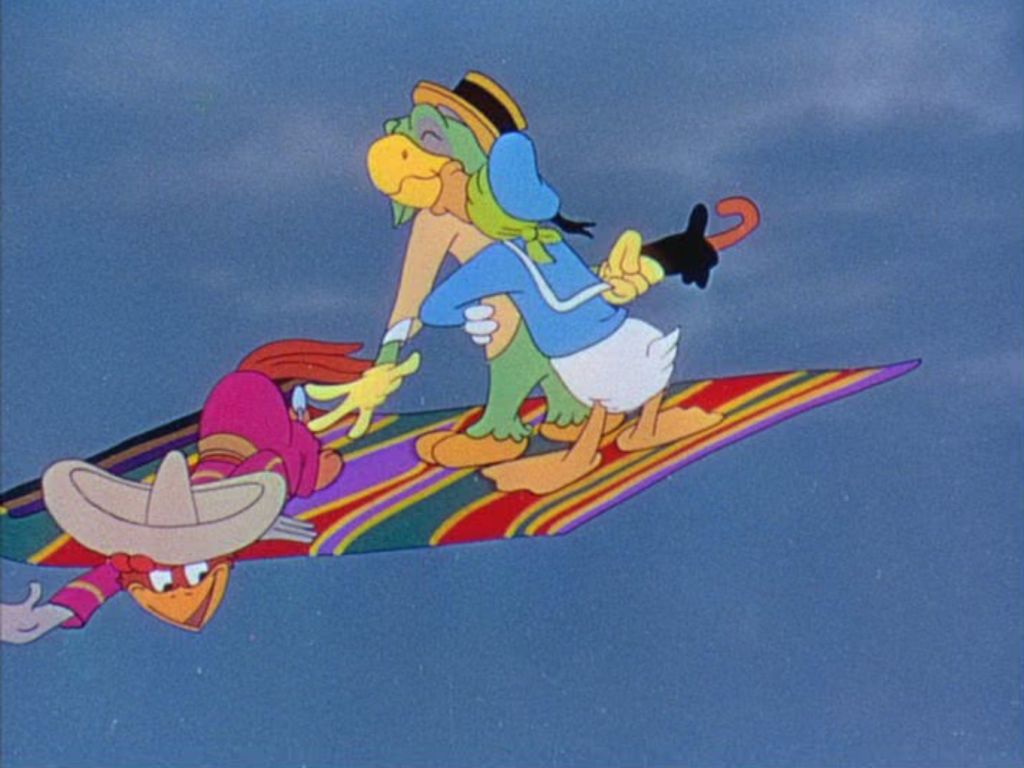
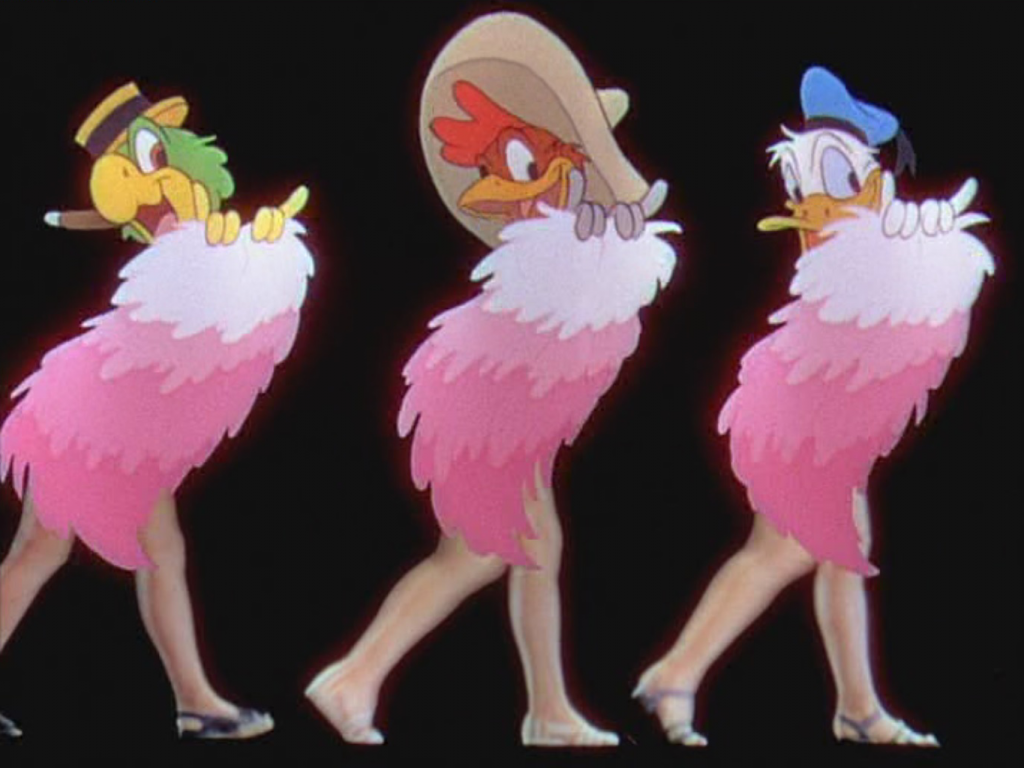
What can I say? It’s sometimes more fun to be childish…
Final Thoughts |
While The Three Caballeros suffers from an inconsistent tone and jarring changes of pace (such as the utterly wild “The Three Caballeros” song being immediately followed by the more serene, religiously themed “Las Posadas”), many of the film’s sequences individually are quite striking.
The biggest issue is its lack of direction – especially towards the end. Rather than instruct or educate with the history, geography, and traditions of South America (the approach taken by Saludos Amigos and the first two shorts of the film), the goal of The Three Caballeros is not to forge an engaging plotline but to plunge its audience into a shared, visceral experience with its characters. When it succeeds, as in the “Baía” segment, the results are intoxicating. When it doesn’t, it leaves the viewer with a hangover.
Man-Card Retribution |

Can’t blame you for that.

Man-Card Retribution: Status Quo
Random Afterthoughts… |
I swear, they must have had the same questionable air flowing through the film’s soundstages that they had pumping into the animator’s rooms of The Reluctant Dragon…

I wonder if there were any immigration issues for Panchito and José being smuggled illegally into the United States inside a package filled with pyrotechnics?
For those who enjoy them, here’s a Hidden Mickey:
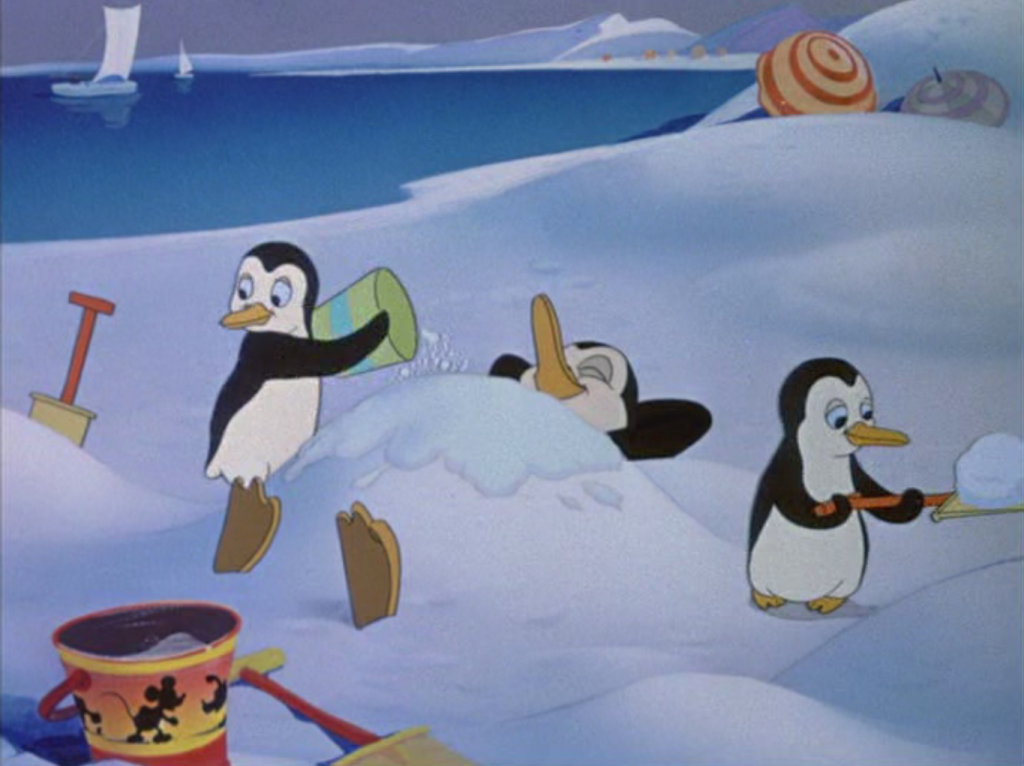
Towards the end of the film, as Donald gazes lovingly at Dora Luz’s starry face as she performs “You Belong to My Heart,” we cut to a nifty shot of her reflection singing in Donald’s eyes.
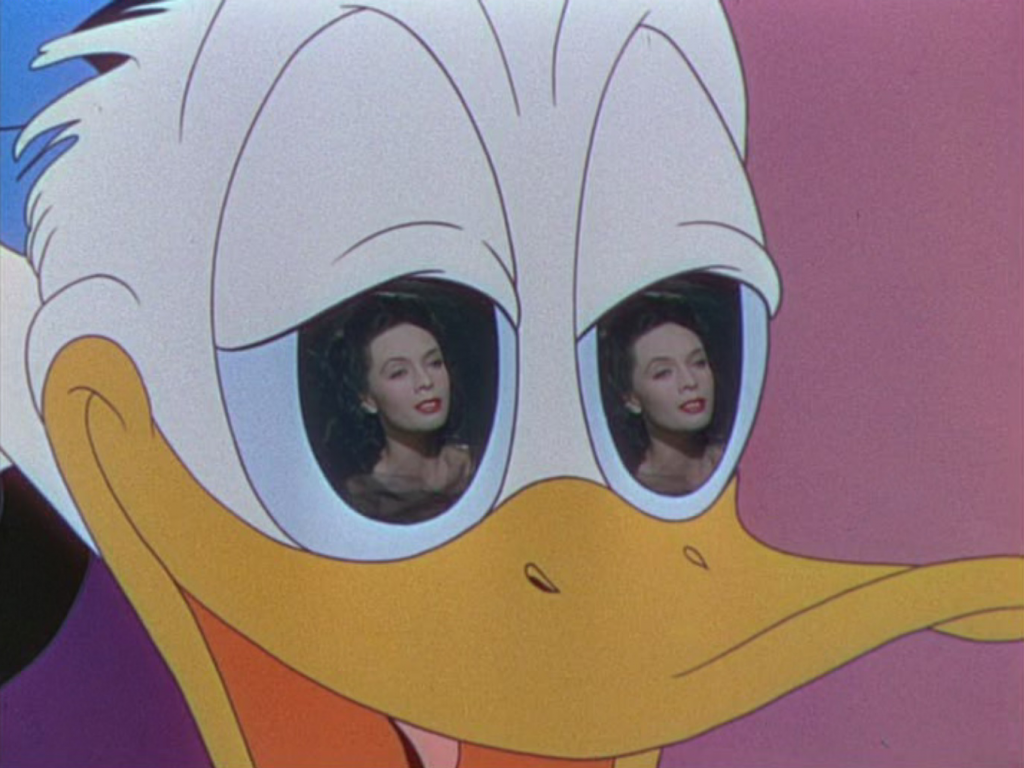
I can’t quite put my finger on it but it seems as though we’ve seen this before. Oh yes, now I remember…
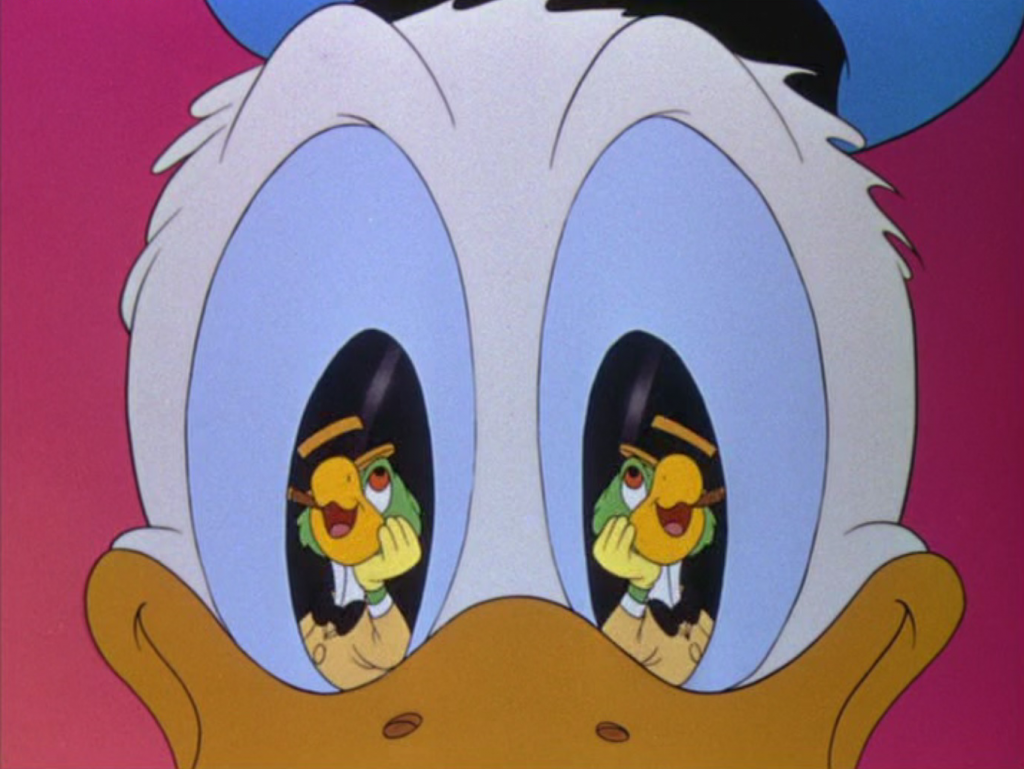
Join us next time as we take a look at yet another Latin-themed Disney short, “El Terrible Toreador” (1929), the second Silly Symphony short cartoon. For more Default Disney, click here.



